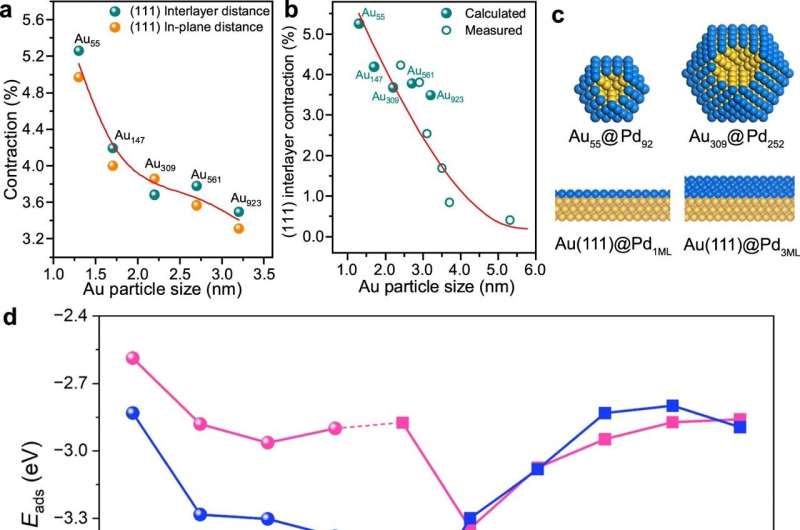Theoretical insight into BzOH adsorption on Pd-based catalysts. a Calculated contractions for (111) interlayer spacing and in-plane distance (in average) for various Au clusters relative to that of Au bulk. b Comparison of calculated contractions for (111) interlayer spacing (on average) over various Au clusters/particles with those measured by transmission electron microscopy. c Models of representative AuNPs@Pd1ML clusters and Au(111)@PdnML slab models; the yellow and blue balls are Au and Pd atoms, respectively. d The adsorption energies of BzOH on AuNP@Pd1ML (pink circle) and Au(111)@PdnML (pink square), and the blue counterparts represent the results without the presence of the Au core inside (for AuNPs@Pd1ML clusters) or the Au substrate underneath (for Au(111)@PdnML slabs). e Top views of BzOH adsorption on Au55@Pd92 (blue = Pd, gold = Au, black = C, white = H, red = O) and the charge density difference contours upon BzOH adsorption on Au55@Pd92, Au309@Pd252, and Au(111)@Pd1ML. The navy blue and yellow contour areas represent the depletion and accumulation of electrons, respectively. Credit: Nature Communications (2023). DOI: 10.1038/s41467-023-36147-2
Recently, a team led by Prof. Lu Junling collaborating with Prof. Li Weixue's and Prof. Wei Shiqiang's team, revealed the conjugated dual size effect of core-shell bimetallic nanocatalysts for the first time, with the activity of the catalysts increases with the core size in the benzyl alcohol oxidation reaction. Their work was published in Nature Communications.
Bimetallic catalysts are widely used in different chemical synthesis for their bimetallic synergy varying with compositions and structures. Compared to alloy catalysts, the peculiar lattice strains and ligand effects of core-shell catalysts can optimize the geometric and electronic properties. The shell thickness significantly affects bimetallic synergy because the ligand effects and the charge transfers between components usually happen at the core-shell interface.
The lattice strains in core-shell catalyst occur due to lattice mismatch between the metal core and the shell, which have a prominent effect on the electronic structure of the metal shell and the overall activity of catalysts. When the core size is reduced, its lattice contracts considerably, which affects its mismatch with shell lattice, consequently modulates the lattice strains in the shell. This dual size effect of core-shell particles has not yet been explored due to the immense challenge in adjusting the core size and shell thickness at atomic level.
To solve these difficulties, the three teams chose solvent-free selective oxidation of benzyl alcohol (BzOH) as probe reaction, and revealed the dual size effect of Au@Pd catalyst using atomic layer deposition, multi-spectroscopy and density functional theory (DFT) calculations. The theoretical calculations conducted by Prof. Li Weixue's team showed that the lattices of Pd overlayer on Au particles expand and tend to enhance BzOH adsorption, while a reduced Au core size would reduce the strains on the Pd shell.
Further calculations found that the ligand effects of Au core would drastically weaken the BzOH adsorption but could became negligible when the Pd shell thickness reached 2 monolayers (ML) and above. Therefore, the highest adsorption energy can be obtained if the large-sized Au core is wrapped by 2 ML thick Pd shell.
To experimentally examine the dual size effect, Prof.LU Junling's team first synthesized Au/SiO2 catalysts with different Au sizes and executed Pd ALD to yield Pd shells with varying thickness on Au particles at atomic level. Then, using transmission electron microscopy (TEM) and X-ray diffraction (XRD), the team revealed the evolution of the atomic and electronic structure of Au and Pd in the core-shell structure with the Au core size and Pd shell thickness.
Results showed that in the oxidation of BzOH, with a fixed Au core size, the activity of catalysts increased with Pd shell thickness quickly and peaked at 2.9ML before it began to drop. With a fixed Pd shell thickness, the activity also improved with increasing core size. The team achieved a maximum activity higher than previous studies in Au6.8@2.9ML-Pd catalyst.
Similar conjugated effect was found in hydrogenation of para-chloronitrobenzene (p-CNB), exhibiting the universality of the effect. This work provided significant guideline for the future design of highly efficient bimetallic catalysts.
More information: Xiaohui Zhang et al, Conjugated dual size effect of core-shell particles synergizes bimetallic catalysis, Nature Communications (2023). DOI: 10.1038/s41467-023-36147-2
Journal information: Nature Communications
Provided by University of Science and Technology of China























